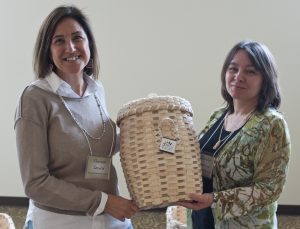How you can help
Metallic green, bullet-shaped and about a half-inch long, the emerald ash borer is expected to cause billions of dollars in damage in the eastern U.S. The larvae kill ash trees by devouring the inner bark, the tree’s main transport system for water and nutrients.
The first step to help keep the emerald ash borer out of Maine is to refrain from bringing in firewood from other states, which is now illegal. To learn more about identifying and reporting a possible EAB infestation, visit the Maine Forest Service website at http://www.maine.gov/doc/mfs/EAB_ID.htm.
Reclaiming a lost art
Last September, Darren Ranco and Jennifer Neptune traveled to Skinner Auctioneers and Appraisers in Boston on an urgent mission: bidding on Penobscot artifacts, including a rare 19th century carrying bag woven from the inner bark of basswood. To Neptune and other members of the Maine Indian Basketmakers Alliance (MIBA), the bag was the key to reviving a lost art.
Maine Indian Basketmakers Alliance members Theresa Secord and Jennifer Neptune display an ash basket made by Richard Silliboy.
“The basswood bag is an example of another way of weaving that people don’t do anymore, but that people are trying to learn and revive,” Neptune told Maine Antiques Digest. Neptune and other basketmakers wanted figure out how to make basswood bags in the event that the emerald ash borer destroyed the brown ash trees they use for their exquisite baskets.
The bag was part of a collection amassed by linguist Frank
Siebert (1912-1998), who worked with the Penobscots to document their language. The collection had been on loan to the Abbe Museum when Siebert’s heirs decided to auction it off.With little time to prepare, five organizations formed the Penobscot Material Culture Collaborative to raise funds to purchase the bag and other items from Siebert’s collection and bring them back to Maine. The organizations included MIBA, the Penobscot Nation Cultural and Historic Preservation Department, the Abbe Museum, the Hudson Museum at University of Maine, and the Bangor Center for History, with endorsement from the Maine State Museum.
Ranco was the designated bidder for the Hudson Museum and Neptune bid for MIBA. He watched the bidding on the bag with growing concern. “As the basswood bag increased in price, I knew Jennifer was reaching her limit,” he recalls.
Finally, Neptune placed the winning bid of $10,073. The bag, which belongs to MIBA, is now on display at the Hudson Museum, along with artifacts Ranco had purchased.
“Jennifer and others had already started to figure out how to work with basswood bark,” Ranco says. “But to have this bag in a place where people can study it every day really makes that seem more possible.”

